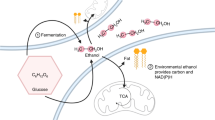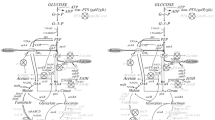Abstract
In the yeast Dipodascus magnusii, which is auxotrophic for thiamine and biotin, during cultivation on glucose with excessive thiamine concentration, pyruvate metabolism was shown to result in the synthesis of fermentation products, namely, ethanol and, to a lesser extent, lactate. Substantial synthesis of ethyl acetate was also observed under these conditions. Introduction of nicotinic acid (NA) into the medium resulted in time separation of ethanol and lactate production. It was shown that cultivation of the yeast under biotin deficiency resulted in nearly complete suppression of aerobic production of ethanol and cessation of ethyl acetate synthesis, whereas lactate synthesis was activated as early as in the first hours of cultivation. Upon introduction of NA under these conditions, lactate concentration sharply increased. These results show that the combination of thiamine and biotin with other vitamins can stimulate utilization of the pyruvate pool in yeasts towards formation of considerable amounts of lactate, which is typical only of cells of higher eukaryotes and bacteria.
Similar content being viewed by others
References
Fiechter, A. and Gmunder, F.K., Metabolic Control of Glucose Degradation in Yeast and Tumor Cells, Adv. Biochem. Engin.Biotechnol, 1989, vol. 39, pp. 1–28.
van Maris, A.J., Winkler, A.A., Porro, D., van Dijken, J.P., and Pronk, J.T., Homofermentative Lactate Production Cannot Sustain Anaerobic Growth of Engineered Saccharomyces cerevisiae: Possible Consequence of Energy-Dependent Lactate Export, Appl. Environ. Microbiol., 2004, vol. 70, no. 5, pp. 2898–2905.
Ashin, V.V. and Trotsenko, Yu.A., Formation and Distribution of Modified FAD between Isozymes of Alcohol Oxidase in the Methylotrophic Yeast Pichia methanolica, Biokhimiya, 1998, vol. 63, no. 12, pp. 1654–1661 [Biochemistry (Moscow) (Engl. Transl.), vol. 63, no. 12, pp. 1407–1413.
Martins, A.M., Cordeiro, C.A., and Ponces Freire, A.M., In situ Analysis of Methylglyoxal Metabolism in Saccharomyces cerevisiae, FEBS Lett., 2001, vol. 499, nos. 1–2, pp. 41–44.
Zvyagil’skaya, R.A., Korosteleva, N.L., and Kotel’nikova, A.V., Characterization of the Mitochondria from a “Fermentative” Variant of the Yeasy Endomyces magnusii, Biokhimiya, 1977, vol. 42, no. 11, pp. 1990–1996.
Meisel’, M.N., Funktsional’naya morfologiya drozhzhevykh organizmov. Izd. AN SSSR (Functional Morphology of Yeast Organisms), Moscow:-L, 1950.
Arfi, K., Spinnler, H.E., Tache, R., and Bonnarme, P., Production of Volatile Compounds by Cheese-Ripening Yeasts: Requirement for a Methanethiol Donor for S-Methyl Thioacetate Synthesis by Kluyveromyces lactis, Appl. Microbiol. Biotechnol., 2002, vol. 58, no. 4, pp. 503–510.
Saksena, N. and Tripathi, H.H., Effect of Organic Volatiles from Saccharomyces on the Spore Germination of Fungi, Acta Microbiol. Hung, 1987, vol. 34, nos. 3–4, pp. 255–257.
Il’chenko, A.P., Ogorelyshev, D.I., Shishkanova, N.V., Sokolov, A.P., Finogenova, T.V., and Kondrashova, M.N., The Effect of Succinate on Respiration, Transamination, and Pyruvate Formation in Cells of the Yeast Dipodascus magnusii, Mikrobiologiya, 2005, vol. 74, no. 5, pp. 609–615 [Microbiology (Engl. Transl.), vol. 74, no. 5, pp. 527–532].
Colombie, S. and Sablayrolles, J.M., Nicotinic Acid Controls Lactate Production by K1-LDH: a Saccharomyces cerevisiae Strain Expressing a Bacterial LDH Gene, J. Ind. Microbiol. Biotechnol, 2004, vol. 31, no. 5, pp. 209–215.
Fiechter, A., Fuhrmann, G.F., and Kappeli, O., Regulation of Glucose Metabolism in Growing Yeast Cells, Adv. Microb. Physiol., 1981, vol. 22, pp. 123–183.
Kawanishi, K., Tada, S., Kajikawa, T., and Ishida, T., Lactate Metabolism and Lactic Acidosis, Rinsho Byori, 1998, vol. 46, no. 8, pp. 804–812.
Author information
Authors and Affiliations
Corresponding author
Additional information
Original Russian Text © A.P. Il’chenko, V.A. Shcherbakova, 2008, published in Mikrobiologiya, 2008, Vol. 77, No. 4, pp. 483–489.
Rights and permissions
About this article
Cite this article
Il’chenko, A.P., Shcherbakova, V.A. Effect of vitamin concentration on the synthesis of lactate, ethanol, pyruvate, and ethyl acetate in cells of the yeast Dipodascus magnusii . Microbiology 77, 430–435 (2008). https://doi.org/10.1134/S0026261708040073
Received:
Published:
Issue Date:
DOI: https://doi.org/10.1134/S0026261708040073




